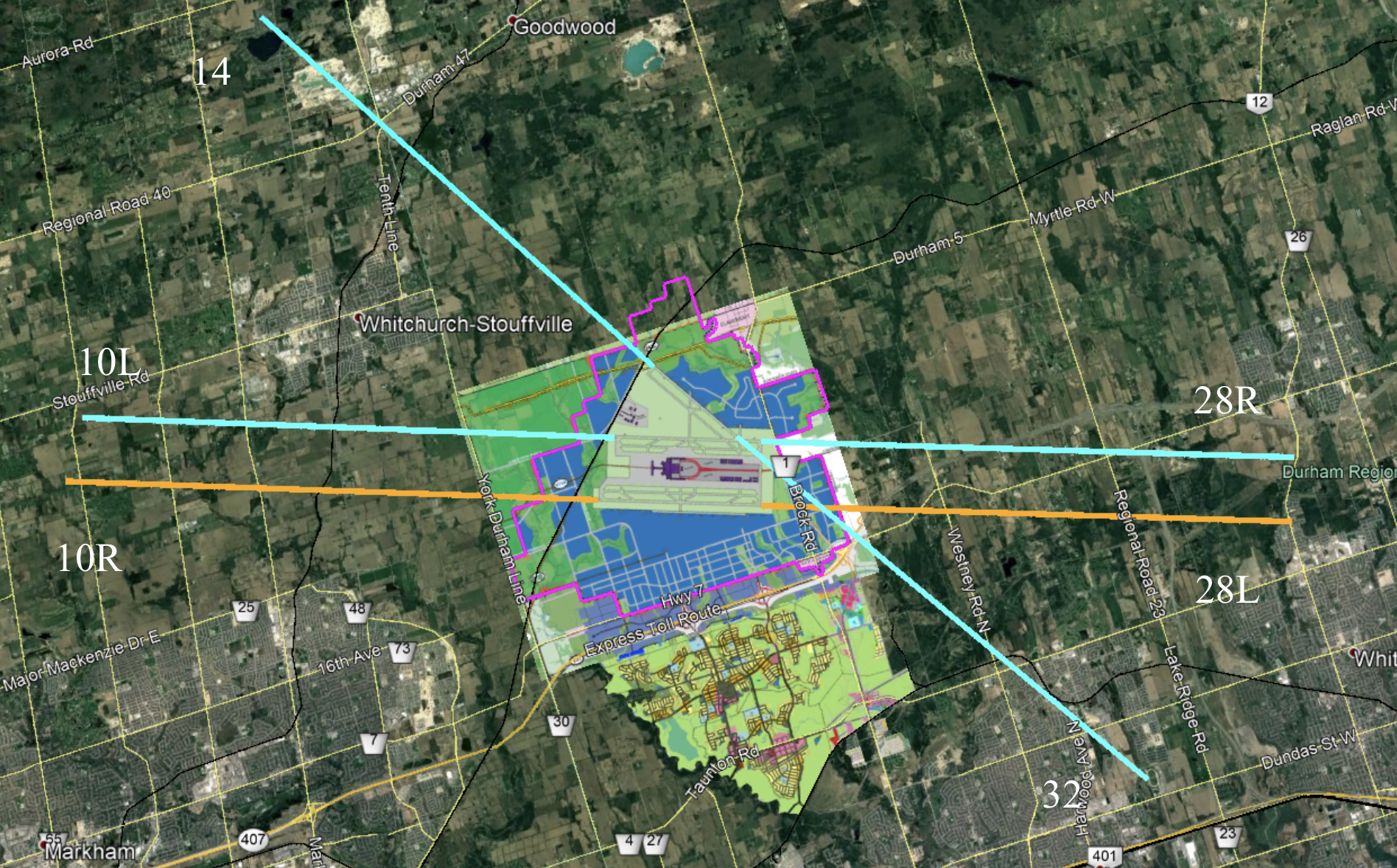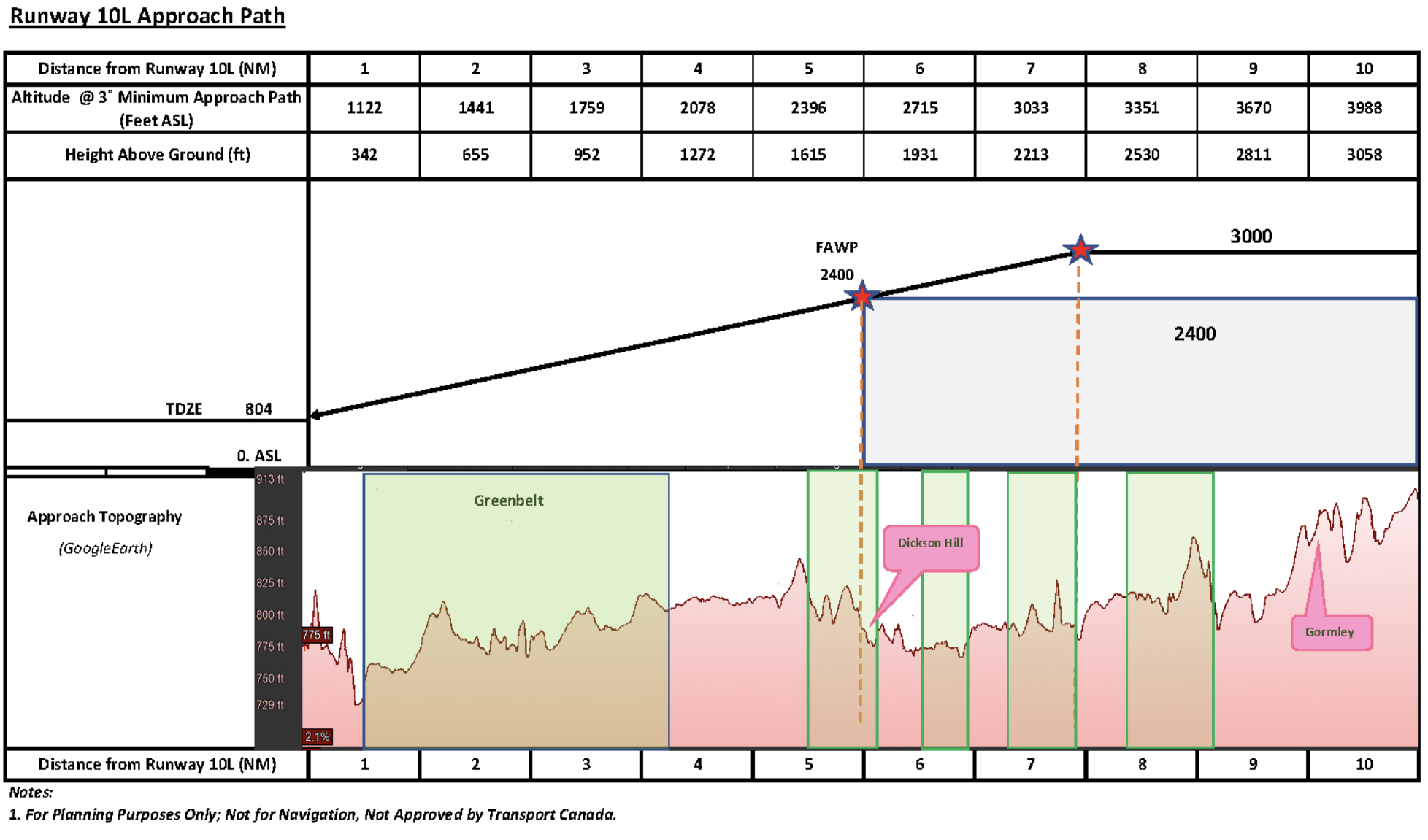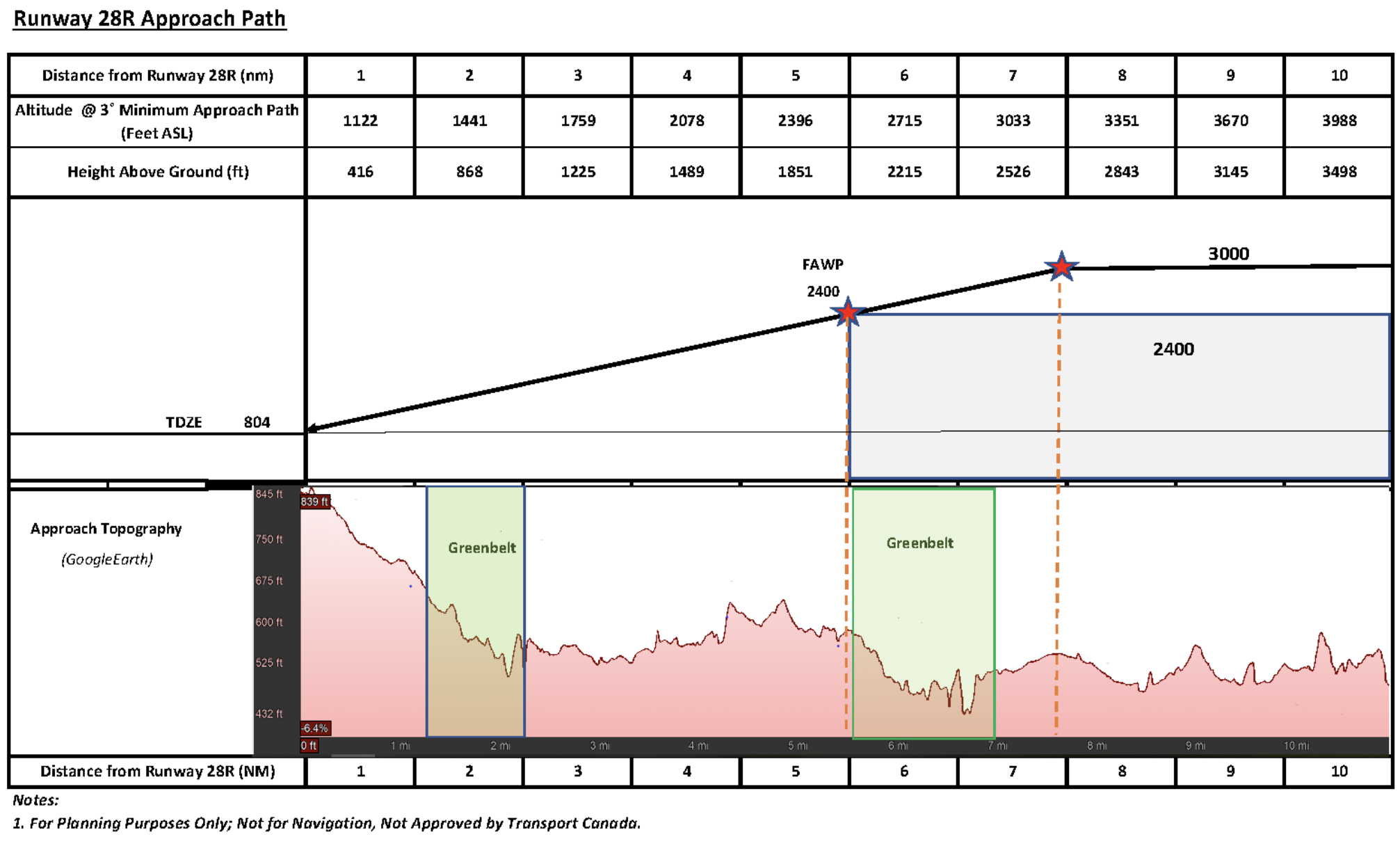Noise pollution caused by jet aircraft is (or should be) a major concern in any large city. Jet travel is omnipresent in every city in the developed world and noise pollution is a downside of being near an airport, including the new Pickering airport. Aircraft already overfly much of the region as low as 3000 ft on the way into Pearson airport. Today aircraft from a local flight school overfly the land reserved for the new airport as low as 500 ft agl ( above ground level). But now jet aircraft will be taking off and landing in North Pickering.
Who will be impacted by the aircraft noise and how loud will the planes flying overhead into Pickering airport really be? The answer to these questions will depend on your location, the aircraft’s height above the ground and the type of aircraft. Thanks to some farsighted planning by Transport Canada, and more recent legislation by the federal and provincial governments, with a few exceptions, the approaches to the new Pickering airport are mostly over the Greenbelt, farm or parkland.

Thanks to the universal use of GPS navigation technology at the new airport, jet aircraft are expected to be following a consistent, narrow path into or out of the new airport. Noise pollution from aircraft landing or taking off from Pickering airport will follow a narrow path aligned with the runways. This type of narrow corridor is now amplifying noise pollution at nearby Pearson airport, now landlocked inside an urban environment. In Pearson’s case, this is concentrating jet aircraft noise into a narrow corridor over existing residential areas, prompting some residents to claim that since 2012 this is creating new “noise ghettos “. Depending on aircraft size, height above ground and the glide path of the approach, aircraft noise from a medium jet starts to be significant approximately 5-7 nautical miles from the end of the runway.
Unlike Toronto Pearson airport, Pickering Airport’s approach paths are designed to be mostly over farm or parkland. The airport will almost certainly be built in multiple phases, with the first phase requiring two runways, an East-West runway (10L-28R ) and a smaller crosswind runway 14-32 (updated from 15-33 for magnetic drift in the May 2017 TC PASZR). A future phase will add in a third runway, East-West 10R-28L. These runway headings and approaches are the same as presented in the “Pickering Airport Draft Plan Report” prepared by the Greater Toronto Airports Authority in 2004, and the mapping released by Transport Canada as part of the 2017 review of the Pickering Airport Site Zoning Regulation. The East-West runways will handle the vast majority of traffic. A map showing the area affected by the federal zoning regulations restricting development is on the Transport Canada website.


Graphic depictions of the approach path for Pickering’s 10L-28R runways with a 3 degree glide path are provided above for discussion purposes only. These charts are not approved for navigation purposes but are provided to dispel the myths around the approach paths. We hope that they will provide a better idea of the noise profile for the new airport. Once an aircraft starts its decent, noise heard under the glide path increases. To quote NATS.AERO, at 3nm from the runway (1000 ft agl) noise from an older medium jet can reach 70 dB. The lower the aircraft the greater the noise.
Even with the airport being in the government’s plan for more than 40 years, some limited development has taken place under the approach paths. These clusters of homes are the exceptions, not the rule, with the airports location and design expected to minimize noise pollution over nearby communities. Examples of some of these exceptions include the following (distances are in nautical miles, runway referenced is for landing traffic):
– The Hamlet of Brougham, which is inside the 1986 Transport Canada define 30 NEP zone.
– Greenwood , three NM (nautical miles ) off the end on 28L. (East of airport)
– Glasgow, 3 NM off the end of runway 14. (North of airport).
– Dickson Hill, 6 NM off the end of 10L. ( West of airport ).
It’s important to note what is not under these approach paths, such as the major communities of Claremont, Markham, Whitchurch -Stouffville and Pickering .
In fact, due to the careful original selection of the site, and ongoing compliance with federal and provincial regulations concerning building homes, schools and hospitals in noise sensitive areas, very few people are expected to be adversely affected. These straightforward facts stand in contrast to misinformation about the airport being spread by some for political or financial gain. Even the Stouffville town funded paper misrepresented the approach paths in its January and February 2018 edition.
Seriously, the airport has been in the government’s plan for 40 years, there is no excuse for approving the development of housing under the approach paths. The misinformation being spread by the town of Stouffville or other groups is completely inappropriate. There is no excuse for the use of FUD ( Fear, Uncertainty, Dread) to pull at the emotions of local residents, or to provide cover to fight for the development of noise sensitive lands.
Local municipal governments are encouraged to continue to deny noise sensitive development within the 30 NEP contour for the airport, and under the well defined Pickering airport approach paths. The Greenbelt regulation facilitates such actions.
Aircraft and airport noise are complex subject matters, but the basic facts are clear, aircraft going into and out of Pickering airport will not be an undue burden on the community. Best of all, Building Pickering airport, with approach paths over farm land and the green belt, will cap and reduce jet noise over densely populated Toronto. Jet aircraft that today have no choice but to squeeze into congested Pearson airport over the heads of hundreds of thousands of Canadians, can now land at nearby Pickering airport instead.
HEY MARK….some of us LIVE in those farmlands and in areas by the greenbelt. You are definitely saying our quality of living and our lives are of far less value than residents in the ‘densely populated Toronto’. You are trying to hide the serious noise impacts under your veil of misrepresentation (your favourite word based on what I have read here). The area I reside in is surrounded by trees…the very types of spaces you think are ideal for flying planes over. Have you stopped to consider that all those people in densely populated Toronto have to come to areas that the TRCA and LSRC and the Oak Ridges Moraine Trails have created for ALL to enjoy even a few moments with and in nature; it is here they can hear wind rustling leaves, bird calls of all kinds, down to the smallest, softest sounds of mother nature. You seem hell bent on ensuring there are NO QUIET green spaces left. Do we all deserve to live like those already under flight paths? Did you ever stop for even one minute to consider that residents in the areas you want to DESTROY, have purposefully and with great intent reasearched then purchased their homes in (often at great expense due to the acerage requirements of building here). That we have carefully decided to live in areas FAR from the Pearson Airport noise ( where frankly developers have squished as many homes per square foot as possible with greatly reduced purchase prices because EVERYONE KNOWS THEY ARE NEAR PEARSON). We did not buy on the land put aside for the Pickering Airport and the fact that you personally feel that the approach paths and the relentless resulting noise is negligible, is a complete (your favourite word again) misrepresentation of the truth. THE TRUTH IS that having a second airport will only make life intolerably noisy for a whole bunch more GTA residents! SERIOUSLY (your favourite way to start a paragraph) adding a second airport SIMPLY MEANS…and it is a simple, simple truth, that there will be noise over everyone’s homes from 4 a.m. one morning till 1 a.m. in the middle of that night. Residents all over the GTA will have the unpleasant reality of NONSTOP noise.
Thanks for improving the quality of no one’s life. If the people near Pearson experience 20% less plane traffic, that means that instead of a plane every 2 minutes it will be what? Every 2.5 minutes? Congratulations Mark!
Are you friends with developers who will be contracted to build this new airport? Are you friends with Pickering council who are so desperate to pretend there will be ‘great jobs’ created as part of their legacy? You are certainly not a friend of nature and leaving some quiet green spaces so we and our children have somewhere to go to escape the noise pollution of Pearson.
First thanks for posting your questions, although I have to admit I am surprised by your assumptions and accusations. But hey at least we are talking, which is the point of the website and a big improvement compared to the past.
First no one in our group, including myself is a developer, although I did help build a deck once. None of us are professional writers, journalists, politicians or in the PR business. Far from it, most are pilots, or in the aviation industry. As a commercial pilot I write between flying gigs, so I apologize if the quality is not up to your professional expectations.
We are volunteering our time and knowledge to support our democracy by helping our citizens and their political representatives of all parties understand what is really going on. In that capacity we have met with a number of politicians as a nonpartisan pro airport group. None of us, including myself have ever been paid by anyone for that hard won expertise.
As described elsewhere on this site, I first discovered that nothing was as it seemed when volunteering as President of the Buttonville flying club. At the time our group decided to do something about it by proposing a not for profit Airpark on the airport lands. Although not accepted, That proposal got us through the looking glass and created the knowledge base that enabled us to write about the subject in an authoritative manner. We are now doing our best to communicate the true economic, political, environmental and international forces at play.
The airport has been on the books for 40 plus years as witnessed by the huge track of land owned by our government and managed by Transport Canada.
A lucky few are able to rent on and enjoy part of this multi billion dollar public land reserve, but it is not there just for them. It is for all Canadians and the time has come to utilize it.
Part of the land has been turned into a park, and is managed by Parks Canada for all of us to enjoy nature. The rest will full fill it’s intended purpose. The question has always been when, not if, the airport will be built. If you have been informed otherwise you should be upset at those that misled you. When the airport is built we will be there cheering on the sidelines, for our environment, our economy and our democracy. I will most likely be retired by then, but I hope to continue to teach others about the freedom, efficiency and environmental importance of flying compared with other modes of travel.
Where and how do we stop this airport??!!! to your point Norine I live where I live to get my children away from all the noise, pollution and congested city like feeling…..we love the forest we live by and all the wildlife!!!
STOP the airport!!
I love how everyone in favor of the airport keeps saying there will still be a park of some sort….great cause I wanna hear and watch airplanes while I am trying to enjoy the sounds of children playing!!
No noise LOL surrrrre
Stop building airport
Stop building airport!!!
Please build the airport, Pearson is a disaster for anyone living North of Toronto.
Stop, farm it … give a chance fir young farmers and grow our own in Ontario
Stop the airport. Give young farmers help to farm the land and feed Ontario home grown.
stop immigration first if you want to stop the airport. There’s no way to support so many populations in the future with current infrastructure capacity